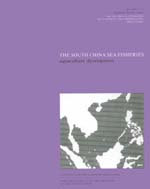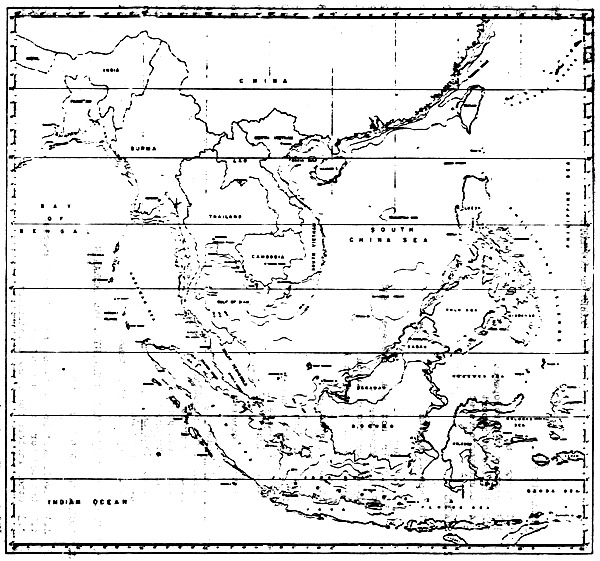
 | STATUS, POTENTIAL AND DEVELOPMENT OF COASTAL AQUACULTURE IN THE COUNTRIES BORDERING THE SOUTH CHINA SEAS |
| South China Sea Fisheries Development and Coordinating Programme | |
| Indo-Pacific Fisheries Council | SCS/DEV/73/5/Rome |
by
Shao-wen Ling
Fishery Biologist/Aquaculturist
This study was prepared on behalf of the South China Sea Programme as a desk review with the collaboration of Dr. H. Rabanal who carried out extensive field visits in the region between July and September 1973.
FOOD AND AGRICULTURE ORGANIZATION OF THE UNITED NATIONS
UNITED NATIONS DEVELOPMENT PROGRAMME
Rome, December 1973
THE SOUTH CHINA SEA FISHERIES
DEVELOPMENT AND COORDINATING PROGRAMME
The South China Sea Fisheries Development and Coordinating Programme (Phase I) was formally conceived by the Indo-Pacific Fisheries Council and its activities have been conducted in close collaboration with that body. The Programme is supported by the UNDP and is being carried out by the FAO Department of Fisheries. This paper, as well as others in a series referred to in SCS/DEV/73/1/Rome, forms the basis for the long-term Phase II programme outlined in that document. The Phase I programme was conducted as an identification project to reflect the wishes and needs of the participating countries for collaborative long-term comprehensive fisheries development.
A.G. Woodland
Programme Leader
STATUS, POTENTIAL AND DEVELOPMENT OF COASTAL AQUACULTURE IN THE
COUNTRIES BORDERING THE SOUTH CHINA SEA
by
Shao-wen Ling
SUMMARY
1. The participating countries of the South China Sea Fisheries Development and Coordinating Programme, including Hong Kong, Indonesia, Khmer, Malaysia, the Philippines, Singapore, Thailand and Vietnam, have a long-standing tradition of fairly common coastal aquaculture practices, due largely to related socio-cultural characteristics, similar climatic and land-sea resources, and the prevaience in the area of the same or related species of fishery resources suitable for culture.
2. Altogether the developed aquaculture areas in these countries are estimated at 430 000 hectares, producing annually about 200 000 tons of finfish and shrimps, 10 000 tons of shrimps and prawns, and 30 000 tons of cockles, oysters, mussels and others.
3. Since the management method in this area is generally extensive rearing of fish in ponds and pens or cages, and in open water for molluscs and seaweeds, production is low; the annual yields are about 500 kg/ha for finfish and 350 for shrimps and prawns.
4. The principal species being cultivated include:
| (a) | Finfish: | Milkfish (Chanos chanos) and grey mullet (Mugil cephalus). Other species not as extensively used are: Anguilla spp., Lates calcarifer, Epinephelus spp., Mylio sp., Chrysophrys sp., Oxyeleotris marmoratus, and Siganus spp. |
| (b) | Crustaceans: | Penaeus monodon, P. merguiensis, P. semisulcatus, Metapenaeus ensis, Macrobrachium rosenbergii, and Scylla serrata. |
| (c) | Molluscs: | Crassostrea spp., Anadara granosa, Mytilus smaragdinus, Pinctada spp. |
| (d) | Seaweeds: | Eucheuma spp., Porphyra sp., Gracilaria sp. |
5. The existing methods in aquaculture are far less productive than those available employing improved technical know-how, trained workers, better equipment, and continuing research.
6. Intensification of production could double production, through (a) augmentation of the fertility of the culture environment, (b) feeding of the cultivated stock, (c) control of pests, predators and diseases, (d) adequate stocking and manipulation of the stock, and (e) the use of other management manipulations.
7. The South China Sea countries have a total of 2.2 million hectares of estuarine and mangrove areas suitable for fish and crustacean culture and 300 000 for mollusc culture. If developed and managed properly these areas could produce 2.5 million tons of fisheries products valued at U.S.$ 1 150 million. The investment required would be about U.S.$ 2 500 million, and labour about 500 000 people.
8. The realisation of increased yields from the existing aquaculture industries, and of production from the undeveloped areas, requires a careful assessment of present conditions and careful planning for programmes of action.
9. The aquaculture industry in the South China Sea area is held back or is threatened by a number of problems:
lack of adequate technical knowledge in aquaculture and supporting services,
inadequate number of technically trained workers of all levels,
inadequate financing scheme,
lack of infrastructure facilities,
insufficient or highly uncertain supply of stocking materials,
inadequate research activities on the biology of the various species cultivated,
lack of a system of marketing that ensures adequate financing and satisfactory method for the distribution of products within the region, or to external markets,
increasing danger from water pollution due to the upsurge of industrialization, continuing and indiscriminate use of pesticides, urbanisation, and population increase.
THE SOUTH CHINA SEA AND ADJACENT WATERS

Hyperlinks to non-FAO Internet sites do not imply any official endorsement of or responsibility for the opinions, ideas, data or products presented at these locations, or guarantee the validity of the information provided. The sole purpose of links to non-FAO sites is to indicate further information available on related topics.
This electronic document has been scanned using optical character recognition (OCR) software. FAO declines all responsibility for any discrepancies that may exist between the present document and its original printed version.
1.1 Background
1.2 History of development
1.3 Purpose of report
1.4 Countries covered
2.1.1 Area
2.1.2 Production and average yield
2.1.3 Manpower
2.1.4 Species cultured
2.1.5 Stocking material
2.2.1 Finfish
2.2.2 Crustaceans
2.2.3 Molluscs
2.2.4 Algae
2.3.1 Indonesia
2.3.2 Khmer Republic
2.3.3 Malaysia
2.3.4 Philippines
2.3.5 Singapore
2.3.6 Thailand
2.3.7 Hong Kong
2.3.8 Republic of Vietnam
3. INSTITUTIONS INVOLVED IN TRAINING AND RESEARCH
4.1 Development prospects of the different species
4.2 Outlook for culture practices
4.3 Other factors favouring development
5.1 Technical
5.2 Personnel
5.3 Financing
5.4 Pollution
5.5 Developmental problems in the area
6. SURVEY OF THE EFFECTS OF WATER POLLUTION
6.1 Indonesia
6.2 Khmer
6.3 Malaysia
6.4 Philippines
6.5 Singapore
6.6 Thailand
6.7 Hong Kong
6.8 Vietnam
7. RELATED ASSISTANCE PROJECTS
Appendix RESEARCH IN AQUACULTURE IN SOUTHEAST ASIA
LIST OF TABLES
1. List of species cultured in countries of the South China Sea region
2. Area under milkfish culture, and potential area of development, Southeast Asian countries
3. Total production and production by unit area of milkfish, four Southeast Asian countries
4. Area under shrimp culture, and potential area of development, Southeast Asian countries
6. Area under mollusc culture and potential area of development, Southeast Asian countries
7. Area under culture, and potential area of development, Philippines
8. Area under culture, and potential area of development, Thailand
9. Estimates of yield and production of coastal aquaculture in Thailand
10. Area of existing coastal aquaculture operations and potential area for future development